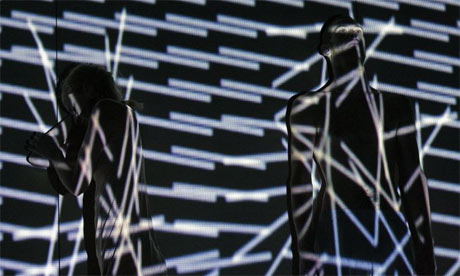
Last week I attended Sam Mendes's rather unmagical version of The Tempest, due to arrive at the Old Vic in June. I can't say that I'd recommend attending, save that Juliet Rylance is an enchanting Miranda and her husband, Christian Camargo, is frequently shirtless as Ariel. That said, the production has one of the niftiest uses of a trapdoor I've seen in ages. And I adore a good trapdoor effect.
New York theatre boasts an abundance of hi-tech artists – from established companies such as the Wooster Group and the Builders Association to newer entrants like Temporary Distortion and the director Jay Scheib. These groups use advanced video, projection, sound and lighting design to enhance their live stage shows. But while I'm a Wooster Group groupie and eager to see Scheib's next show, I do wish that more theatre-makers went retro in their use of technology. Rather than merely seeking out the latest in computer programs or video effects, perhaps more companies could draw on the already rich history of theatrical machinery and innovations.
Obviously, the stage isn't a cinema, a television or a computer screen. Its great selling points are its liveness and its human scale. When a play tries to imagine itself as a film, the results are often disappointing, as in The Phantom of the Opera's slowly descending chandelier or Mary Poppins's erratic levitation. And I don't doubt that the effort to recreate filmic effects has hampered the much delayed Spider-Man musical.
Sometimes, as in the Wooster Group's work, the use of actual film and video meaningfully augments a production, but too often it distracts the eye away from the stage and fixes it on the screen, distancing you from the human actors present. Sometimes the most splendid effects make for the most miserable shows. There's a theatre in the financial district, 3LD, that has all the niftiest toys, including a projector that produces astonishing 3D images, but I'm hard-pressed to think of a single show in which the gadgets have enhanced the play. As a fellow critic recently claimed, "a lot of artists risk losing liveness because everything is on an automated computer system – the score, the lighting. You can tech yourself out of that live magic very easily."
Admittedly, some of the theatre's past technology was cutting-edge, such as the carriage that delivered the deus ex machina or the wonderful systems of ropes and pulleys used to deploy scenery. (I once spent a delighted hour marvelling at the weblike riggings beneath the Drottningholm Palace theatre.) And I'm not necessarily calling for a return to Hamlet played with fright wigs or actual limelight. (Although designers should feel free to bring back those wind machines. I have cranked one. It was awesome.)
In thinking back over the past season, it strikes me that so many of my favourite effects were the simpler ones, like the snow slowly churned by an actor in Radiohole's Whatever, Heaven Allows or the dance with a glowing wire in L'Effet de Serge or the wonderfully slapdash devices of Machines, Machines, Machines, Machines, Machines, Machines, Machines. My verdict? Give me more high art with low-tech – it's unsophisticated, but truly marvellous

